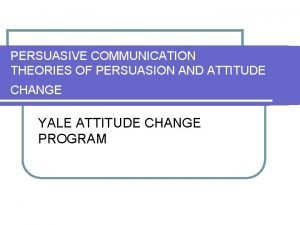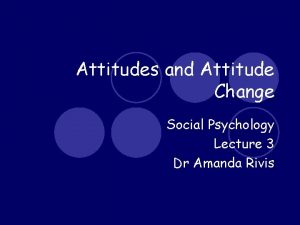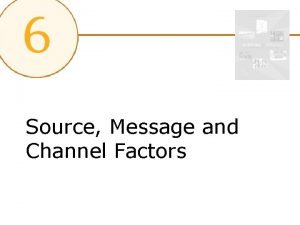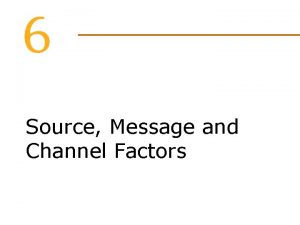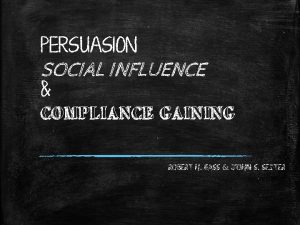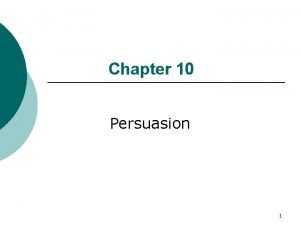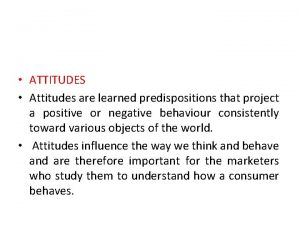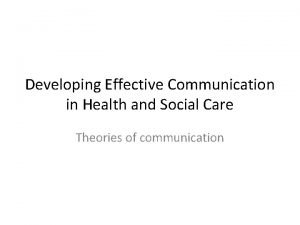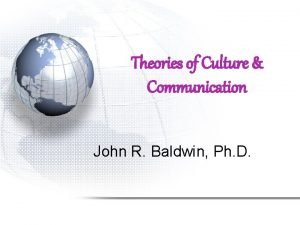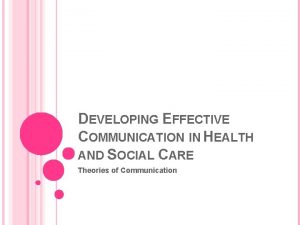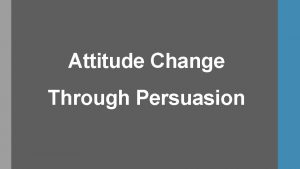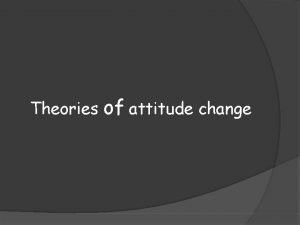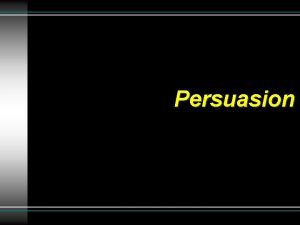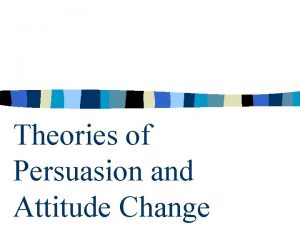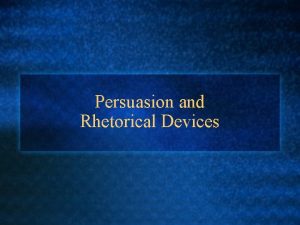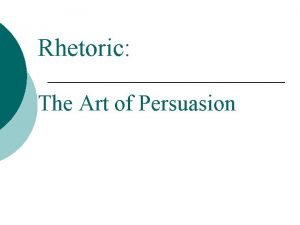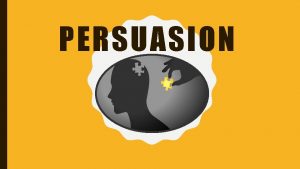PERSUASIVE COMMUNICATION THEORIES OF PERSUASION AND ATTITUDE CHANGE










- Slides: 10

PERSUASIVE COMMUNICATION THEORIES OF PERSUASION AND ATTITUDE CHANGE YALE ATTITUDE CHANGE PROGRAM

YALE ATTITUDE CHANGE PROGRAM l PROCESSES: The Yale approach specifies four kinds of processes that determine the extent to which a person will be persuaded by a communication.

PROCESSES: l 1. ATTENTION: One must first get the intended audience to listen to what one has to say. l 2. COMPREHENSION: The intended audience must understand the argument or message presented. l 3. ACCEPTANCE: The intended audience must accept the arguments or conclusions presented in the communication. This acceptance is based on the rewards presented in the message. l 4. RETENTION: The message must be remembered, have staying power.

VARIABLES l The Yale approach identifies four variables that influence the acceptance of arguments.

VARIABLES l 1. SOURCE: What characteristics of the speaker affect the persuasive impact? l 2. COMMUNICATION: What aspects of the message will have the most impact? l 3. AUDIENCE: How persuadable are the individuals in the audience? l 4. AUDIENCE REACTIONS: What aspects of the source and communication elicit counter arguing reactions in the audience?

The Persuader l 1. There will be more opinion change in the desired direction if the communicator has high credibility than if he or she has low credibility. Credibility is: Expertise, Trustworthiness, Dynamism & Sociability l 2. The credibility of the persuader is less of factor in opinion change later on than it is immediately after exposure.

The Persuader Cont. l 3. A communicator's effectiveness is increased if he/she initially expresses some views that are also held by the audience l 4. What an audience thinks of a persuader may be directly influenced by what they think of the message. l 5. Communicator characteristics irrelevant to the topic of the message can influence acceptance of its conclusion.

How To Present the Issues l 1. Present one side of the argument when the audience is generally friendly, or when your position is the only one that will be presented, or when you want immediate, though temporary, opinion change. l 2. Present both sides of the argument when the audience starts out disagreeing with you, or when it is probable that the audience will hear the other side from someone else. l 3. When opposite views are presented one after another, the one presented last will probably be more effective. l 4. There will probably be more opinion change in the direction you want if you explicitly state your conclusion than if you let then audience draw their own, except when they are rather intelligent: Then implicit conclusions are better. l 5. Fear appeals: The findings generally show a positive relationship between intensity of fear arousal and amount of attitude change if recommendations for action are explicit and possible, but a negative reaction otherwise.

Audience as Individuals l 1. The people you may want most in your audience are often least likely to be there. l 2. The level of intelligence of an audience determines the effectiveness of some kinds of appeals. l 3. Successful persuasion takes into account the reasons for underlying attitudes as well as the attitudes themselves. l 4. Individual's personality traits affect his/her susceptibility to persuasion, people are more easily influenced when their self esteem is low. l 5. There are individuals who are highly persuadable and who will be easily changed by any influence attempt, but who are then equally influenced when faced with counter communication. l 6. Ego-involvement with the content of the communication (it's relation to value of the audience) increases the acceptance of its conclusion

The Persistence of Opinion Change l 1. In time, the effects of a persuasive communication tend to wear off. l a) A communication from a positive source leads to more rapid decay of attitude change over time than one from a negative source. l b) A complex or subtle message produces slower decay of attitude change. l c) Attitude change is more persistent over time if the receiver actively participates in, rather than passively receive, the communication. l 2. Repeating a communication tends to prolong its influence. l 3. More of the desired opinion change may be found some time after exposure to the communication than right after exposure (the sleeper effect).
 Yale attitude change approach to persuasion
Yale attitude change approach to persuasion Petty and cacioppo's model of persuasion
Petty and cacioppo's model of persuasion Communication-persuasion matrix
Communication-persuasion matrix Source message and channel factors
Source message and channel factors Gass and seiter model
Gass and seiter model Hovland persuasion model
Hovland persuasion model Types of attitude
Types of attitude Attitude and value change
Attitude and value change Argyles theory of communication
Argyles theory of communication Co cultural theory definition
Co cultural theory definition Theories of communication in health and social care
Theories of communication in health and social care
